This was published 6 years ago
Opinion
Cry me a river: Mismanagement and corruption have left the Darling dry
By Helen Vivian
‘‘Where is the water? The Darling River has 22 tributaries. We have a buyback program for environmental flow. We spend billions. Where’s the water?’’
This post on Facebook by Mildura chef Stefano de Pieri got me thinking.
I went up to Pooncarie yesterday to try to come to grips with the state of the Darling River. The Darling River has had 15 "cease to flow" events since 2001, the longest being 520 days.
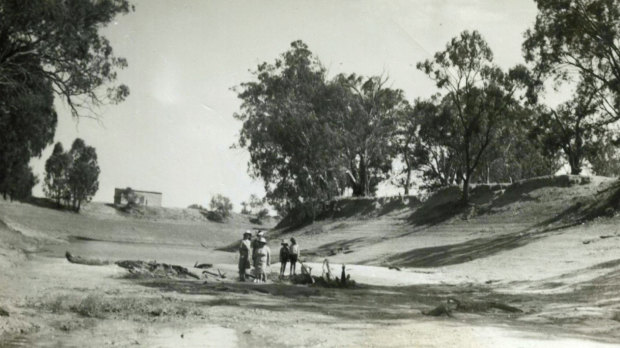
Roy Smith, his wife Nel and their son Barrie are among those standing in the Darling River bed at Balcatherine Station, c.1945. Balcatherine has been in the Smith family for five generations. Credit: Courtesy of Marie Smith
Prior to 2001, the last time the river was dry was about 1945, after the big drought during World War II. Curiously, the previous big drought was during World War I. Like the old river just ran out of heart and gave up, it was all so sad.
There must be millions of pages of reports written on the Murray-Darling Basin, mostly by people sitting in desks in capital cities.
Have they ever seen the Darling? Because there is no escaping the state of this once magnificent river. It's like a giant neon emergency signal flashing across the four most populous states in the country. Depleted, despoiled, often poisonous and since 2001 frequently dry, the Darling River is an emblem of poor government, mismanagement, greed and anti-democratic activity.
The lower Darling River is in so much trouble that a 270-kilometre pipeline is being built to supply Murray River water to Broken Hill, which used to supplement its water supply from the Darling River via the Menindee Lakes.
The new pipeline is needed because the Menindee-to-Broken Hill pipeline, which has been used for the last 65 years, can no longer access a reliable source of water from the Darling. Despite a dramatic fall in the population of Broken Hill since the 1970s, there is no longer enough water flowing down the Lower Darling River into the Menindee storage because of the increased water use upstream.
That’s what they call the Menindee Lakes now – storage, not lakes. There is a push to "decommission" the lakes - in other words, to dry them out - which will cause further devastation to the Lower Darling.
The argument is that there is too much evaporation from the lakes, which are shallow, and that’s wasteful. The new on-farm dams that have been built upstream in northern NSW and southern Queensland by cotton growers in the home country of the former and current water ministers, Barnaby Joyce and David Littleproud, are much, much bigger and deeper, so evaporation is not such a problem. It’s much more efficient.
This argument about reducing evaporation losses apparently does not apply to flood plain diversion levees on private farms. Masquerading as environmental mitigation works, funded by the taxpayer, farm levees have been constructed to create vast on-farm water storages, in some cases the size of Sydney Harbour.
Major crimes police raided the Norman farm at Goondiwindi last year after allegations of fraud relating to misuse of $25 million of taxpayer funds provided for water saving programs.
And this week it was announced that WaterNSW would prosecute five people for water theft, after the NSW Ombudsman pointed out that - contrary to statistics WaterNSW provided to the government - no penalty enforcement notices for water theft had been issued between July 2016 and November 2017.
The Wentworth-Broken Hill pipeline has happened very fast for a government project. The NSW government approved the $467 million project in late 2016. The contract was awarded and announced in October 2017, in the same month that the business case for the pipeline was published (Broken Hill Long-Term Water Supply Solution). Detailed design and planning was carried out after the awarding of the contract (according to WaterNSW) and apparently completed within two months, as work commenced in January 2018.
The pipes have already been delivered - a large quantity can be seen lining the chosen route on the western side of the Silver City Highway outside Wentworth.
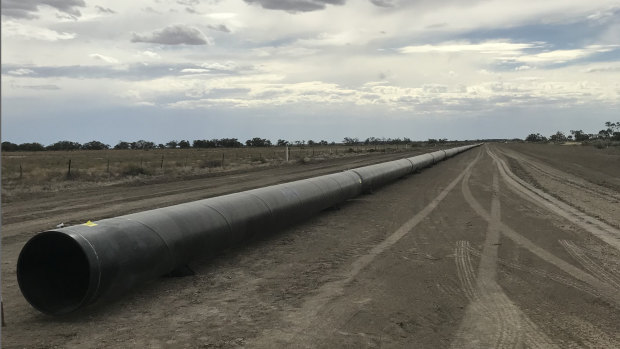
Steel pipes lining the Silver City Highway north of Wentworth.Credit: Helen Vivian
It’s good to know that Australian steel manufacturers can produce 28,000 tonnes of steel and deliver a significant proportion of the 270 kilometres of rolled steel pipes, approximately 80 centimetres in diameter, in just two months.
According to the WaterNSW website: ‘‘The pipeline will be completed and ready for water by December 2018. It will supply up to 37.4 megalitres during peak daily demand.’’
To give you an idea how much water that is, 37.4 megalitres per day is 433 litres per second, or 1.5 million litres per hour pumped out of the Murray.
The Wentworth-Broken Hill pipeline will fix things for Broken Hill, which can no longer rely on the Darling for its water supply. It will also ensure secure water supply for two new mines, Perilya Mines and Hawsons Iron Project.
Finally, we can mark a new achievement in our technological progress calendars. It’s not quite up there with going to the moon, but we have made water flow uphill and into the deepest pockets, just as some predicted when water was first commodified and "decoupled" from the land.
It is hard to untangle water issues as upstream users square off against those downstream. There are dozens of different types of water titles, and a litany of government regulations which vary between states. Then there is the ad hoc manner in which many of these are applied. Whilst water is rigorously metered throughout Victoria, nearly 75 per cent of farms in the headwaters of the Darling are unmetered, so an honesty system effectively applies.
In 2012 the NSW government increased water entitlements and allowed upstream users to draw water from the river even during low flow periods. The Barwon-Darling water-sharing plan has been contentious from the day it was introduced and serious allegations were raised last month about the conduct of the then minister for primary industries, Katrina Hodgkinson, for unilaterally altering the plan after it was finalised by her department.
In July 2017 the ABC Four Corners program ''Pumped'' revealed astounding malpractice and alleged corruption, which is currently being investigated by the Independent Commission Against Corruption (ICAC). Some of these allegedly corrupt transactions hide behind a veil of incompetence. Hundreds of millions of taxpayer dollars have been spent on water "buybacks", where the government has paid twice the going rate for water which effectively does not exist, except during heavy rainfall and peak water conditions.
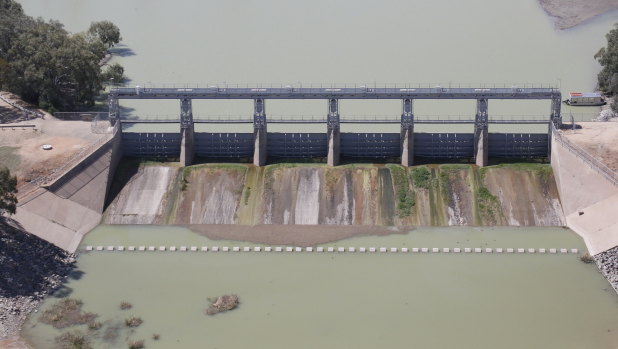
The Menindee Weir in the middle of the Darling River, which allows water to be regulated to the Menindee Lakes. Credit: Richard Kingsford
The first of these was the purchase of $34 million of supplementary water rights, described locally as "empty buckets of water", sold to the federal government during the Millennium drought in 2008 by Tandou Station, 100 kilometres south-east of Broken Hill and just south of the Menindee Lakes. A further water sale to the federal government was made last year by the same station, $78 million for their entire 21,900-megalitre water right and for business readjustment.
As was reported last month, that deal - personally negotiated by Barnaby Joyce - was at more than twice the market price for water.
That’s $112 million of taxpayer funds to one station, Tandou. Webster Limited has owned Tandou since 2015. The company also owns several large cotton properties upstream at Bourke and Moree.
Webster, a Tasmanian company, is also one of Australia’s biggest water traders. Its shareholders include Australian Food and Fibre, which is controlled by the Robinson family, a major donor to the National Party.
The outcome from this $112 million investment of taxpayer funds is that Webster will decommission the irrigated horticultural enterprise at Tandou and return the property to dry-land farming. They will take all the promised jobs and economic activity with them to their northern NSW holdings, where they get to intercept the water before it enters the Darling River.
This is the real kicker - the $112 million water "buyback" will do nothing to benefit the river or water users downstream.
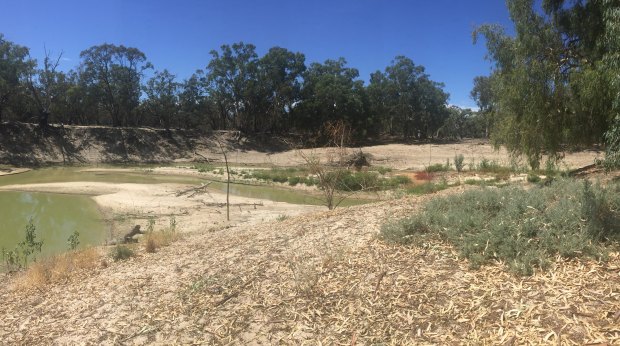
The Darling River south of Pooncarie on the Smith property, Balcatherine Station.Credit: Ross Lake
We now know that this was not an isolated case. Last month, Fairfax’s Peter Hannam revealed details of a $17 million purchase in March 2017, at twice the market price for water, from the Tulla Pastoral Company, owned by Geoff Dunsdon, in the Warrego River in southern Queensland. This was also empty buckets of water – or "goanna water" as they call it further north.
According to the November 2017 Matthews Report, commissioned by the NSW government in the wake of the explosive allegations aired by Four Corners, most of the effective water controls and regulation do not apply, or are not complied with, in the Upper Darling Basin.
Joyce confirmed in an interview with The Australian that the deal with Webster meant that some of the five lakes making up the Menindee storage system would be permanently "decommissioned".
The Australian reported that Joyce said letting the lakes dry out would save precious water for irrigators in the cotton communities of St George and Dirranbandi, in southern Queensland, and Bourke, Wee Waa and Moree in northern NSW. This was "a much better alternative than having to withdraw water entitlements from large cotton producers like Chinese-owned Cubbie Station, the biggest user of water in Australia".
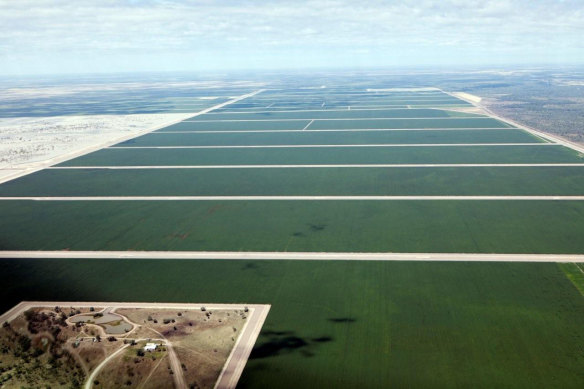
Cubbie Station in Queensland, the biggest user of water in Australia.
Some will say it’s the drought causing problems in the lower Darling. But there have also been floods and generous flows throughout this period. In June 2016, approximately 60,000 megalitres of water per day was measured flowing down the Macintyre River at Boggabilla, in the Darling River catchment on the border of NSW and Queensland.
The Macintyre forms the northern boundary of Joyce’s New England electorate. By December 2016, the Menindee Lakes were at 89 per cent capacity. Just four months later they were down to 45 per cent, presumably a good deal of this water flowing to Tandou Station, a few kilometres south of the lakes.
Very little if any of the water from the floods in early 2017 reached the Menindee Lakes. It was allocated and distributed to upstream irrigators. The recent frequent drying of the Darling River is a man-made situation. Fifty-six years passed between the "no-flow events" of 1945 and 2001. Now they are an almost annual occurrence and the length of time during which the river ceases to flow has doubled.
Alarm bells rang from the very start of the water reforms and an ABC News report, "Water Wars", summed up the problem succinctly: ‘‘In 2008-9 … whilst urban water users faced severe restrictions … and the vast majority of the Basin was enduring the peak of the worst drought in living memory, the cultivation of cotton and rice consumed 981 gigalitres of water. This figure equates to the combined water consumption of Sydney, Melbourne and Adelaide (990 gigalitres) over the same period, to produce a crop with a combined value of less than $650 million, in a year when the gross value of national agricultural production was in excess of $46 billion.’’
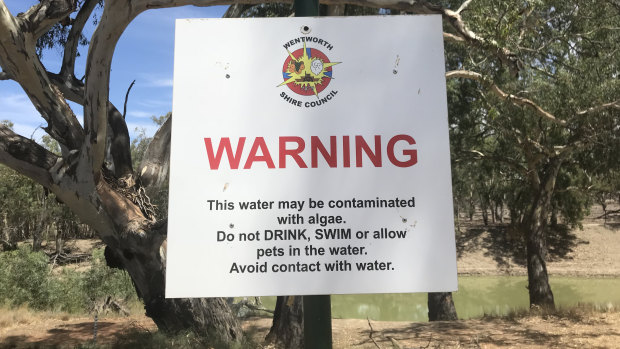
Municipal sign at the old wharf site, Pooncarie, February 2018.Credit: Helen Vivian
This transfer of water and wealth to a very small number of corporate farming operations comes at great cost to the river and cannot be justified economically, let alone environmentally or socially.
The Wentworth-Broken Hill pipeline is a vital element in what increasingly looks like a plan to sacrifice the Lower Darling to the interests of the cotton industry upstream.
Broken Hill is the only populous area in the region that relied on the river. It was a problem that needed to be solved, given the NSW government's statutory responsibility to maintain water supply to the township. But Broken Hill’s gain will certainly be a loss to those on the Lower Darling and further downstream.
The RM Consulting Group's report on the pipeline, prepared for WaterNSW in July 2017 and finalised in November 2017, states that the pipeline is designed to supply 100 per cent of Broken Hill’s water requirements. Why 100 per cent? Broken Hill does have some water resources of its own or it wouldn’t be there.
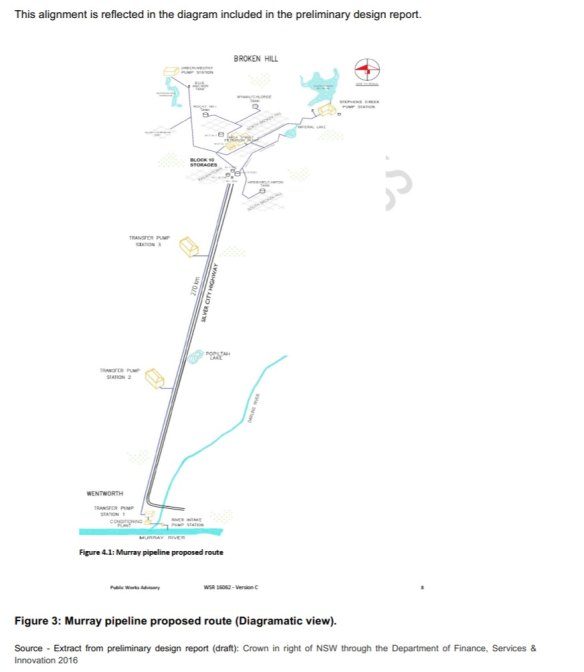
The proposed route of the Wentworth-Broken Hill pipeline, as shown in the RM Consulting Group's 2017 report.Credit: RM Consulting Group
The current average cost of water to consumers along the pipeline is $740 per megalitre, based on usage charges to consumers along the pipeline as set out in the report. So the value of the 37.4 megalitres of daily water the pipeline will supply is $26,928 per day, or about $10 million a year. That’s $467 million spent to supply $10 million of water per year, assuming the pipe flows at capacity 365 days a year.
The Lower Darling is the area between Broken Hill, Menindee and Wentworth. It is characterised by dryland grazing which occupies 91.5 per cent of the area while "native landscapes" comprise 1.9 per cent. Irrigated horticulture accounts for less than 0.1 per cent of land use in the Lower Darling, according to a NSW Department of Primary Industries study of 2012.
Having recently driven through this devastated landscape, it is hard to imagine the potential for ecotourism pointed to in the RM Consulting Group's report. But then again, I am from Tasmania where wilderness is wilderness and rivers have been saved by direct community action, in the days when it was possible to congregate to protest such schemes without fearing imprisonment as a terrorist.
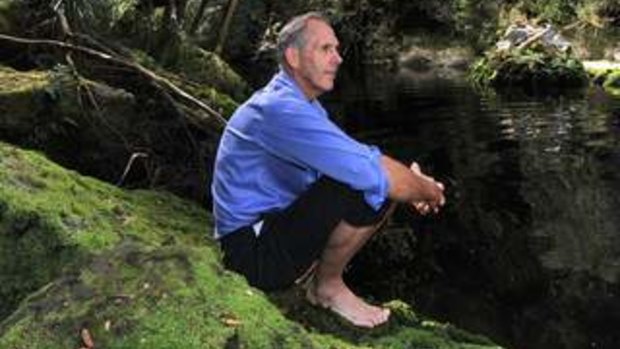
Bob Brown on the banks of the Gordon River in Tasmania.Credit: Joe Armao
Recently, Bob Brown challenged the new Tasmanian anti-congregation laws when he was arrested at a logging protest in October 2017. The Victorian, NSW, Queensland, South Australian and federal governments joined Tasmania in fighting Brown’s challenge to the laws.
The High Court found that ‘‘the laws were at odds with the implied right, in the Australian constitution, to the freedom of political communication''. The Tasmanian government was ordered to pay costs in the case.
People do have the right to protest destruction of their environment and no one should be afraid to stand up when the future of Australia’s most iconic rivers is at stake. Several of those involved in organising recent demonstrations against the pipeline in Wentworth expressed fear of the harsh penalties applied by the anti-congregation laws and said they could not afford legal representation should they be arrested.
This is not just about one river, though that would be enough. It’s about the whole Murray-Darling Basin, the ecology, people and creatures who depend upon the Basin, the communities and cities downstream, the fisheries which spawn in the Darling and populate the rivers downstream. Above all it is about the state of our nation.
Alleged corruption and collusion with cotton growers in the northern Basin has already claimed the scalp of the deputy director-general of water at the NSW Department of Industry, Gavin Hanlon, and increasingly there are concerns that it may extend to ministerial levels. When corruption reaches these sorts of levels, the functioning of our democracy is at risk.
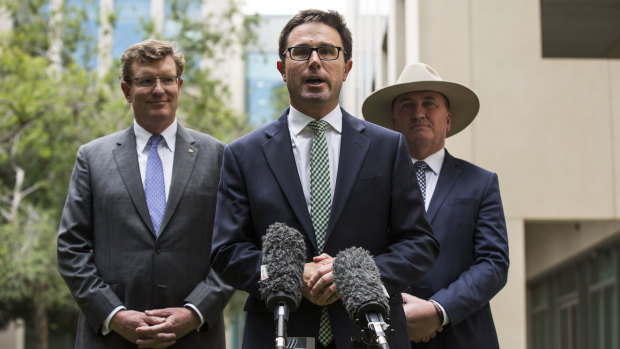
David Littleproud speaks in February, with then deputy prime minister Barnaby Joyce to his left.Credit: Dominic Lorrimer
After more than $8 billion has been spent, the capacity of our governments and authorities to deliver anything of value to their citizens is in question. If we are prepared to sacrifice the Darling River, what future can we contemplate for Australia?
The Federal Minister for Water, David Littleproud, met with concerned lower Darling residents in Mildura on Thursday. He said he did not know some of the locations referred to by the invited audience.
He is the minister. It’s his back yard. There is real-time satellite tracking of water flows that shows exactly where the water is going.
The obfuscations just keep on rolling out. The Darling has no tears left to cry.
Helen Vivian is a writer and curator with an MA in Environmental Studies from the University of Tasmania and an MA in Visual Culture from Monash University.